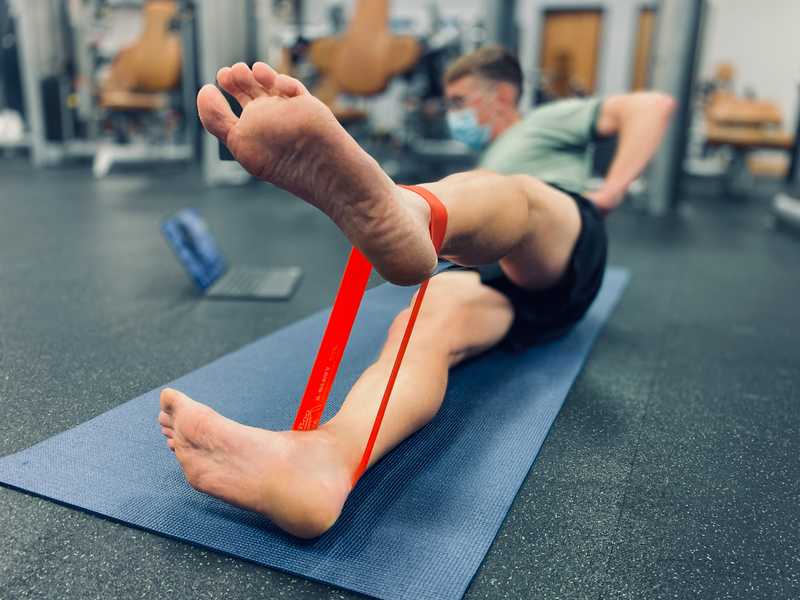If you've ever called your physician to discuss your symptoms, or your child's symptoms when they had a fever, you've already participated in telemedicine. The COVID-19 pandemic accelerated the adoption of telemedicine by many people and their healthcare providers. This change in delivering medical care has revolutionized the way you can get access to high quality treatment.
Physical rehabilitation, such as physical therapy and occupational therapy, is a somewhat recent addition to telemedicine. Given the often hands-on approach of traditional PT and OT, perhaps you are curious if virtual telehealth rehabilitation is worth trying.
Telehealth rehabilitation has rapidly gained in popularity in recent years and comes with some pretty awesome benefits. Continue reading to learn some surprising reasons to give it a try from someone who has experienced it both as a clinician and as a patient.
Table of Contents
- A Brief History of Telehealth Rehab
- What Does Telemedicine Rehabilitation Cover?
- How Does Virtual Rehabilitation Apply to Physical Therapy?
- The Effectiveness of Virtual Physical Therapy
- 9 Reasons to Try Telehealth Rehabilitation When You Need Physical Therapy
- Next Step: Try Virtual Telehealth Rehabilitation to See for Yourself
A Brief History of Telehealth Rehab
As early as 1879, physicians have used telephone consultations as a way to advise patients without the requirement of an in-person visit.1 Electronic medical records allowed pharmacists2 and radiologists3 to consult from afar. And recently, with widespread accessibility of real-time videoconferencing, people are able to see any provider without having to be physically present with them in the same room.
What Does Telemedicine Rehabilitation Cover?
For many, psychiatric or drug rehabilitation comes to mind when they think of rehabilitation. Telehealth rehabilitation also includes physical rehabilitation, such as the consultation and care by a licensed physical therapist, occupational therapist, or their assistant. It could also include services provided under the expertise of a speech-language pathologist, physiatrist, or respiratory therapist.
How Does Virtual Rehabilitation Apply to Physical Therapy?
Physical therapy has evolved over the decades, always with the goal of enhancing the human experience. Whether physical therapy treatment is in-person or virtual, treatment aids in optimizing physical function and overall well-being. As with in-person services, your virtual rehabilitation would include:
- An initial evaluation (including questions about your symptoms and objective measurements),
- A series of follow-up visits dependent upon your schedule and the intensity of your problem or diagnosis, and
- A progression of specialized exercises and a plan of care to move you toward your goals.
Additionally, you would be able to contact your therapist in between scheduled visits should an issue arise or should you have a question or need further clarification.
The Effectiveness of Virtual Physical Therapy
Since physical therapy has historically been practiced as a "hands on" approach, you may find yourself skeptical of online physical therapy.
Telehealth rehabilitation is an effective way to treat many musculoskeletal conditions. As a clinician, when I first started doing video visits, I was pleasantly surprised at how well I was able to evaluate and educate people without being physically present with them. And my clients and I were both surprised at how their condition improved as well.
Research Supports Virtual PT
Current clinical research supports what my clients and I anecdotally observed. The therapist's assessment and diagnosis,4 as well as the client's outcomes, are quite similar when comparing in-person and remote or virtual rehabilitation.
Similarly, patients and clinicians report high levels of satisfaction with virtual interactions when clinicians are properly trained. We discuss and cite this research finding and more in our article about the effectiveness of virtual physical therapy.
9 Reasons to Try Telehealth Rehabilitation When You Need Physical Therapy
Now that we have established what remote physical therapy is, let's dig into why you might want to give it a try.
1. Access to the Best with One Click
Some physical rehabilitation specialties, such as pelvic health, may be difficult to access in your area. The nearest provider may have a long wait list or may be located inconveniently from where you live or work.
With virtual rehab, distance is not a barrier to high quality care. You can choose and read about CityPT's therapists to find a specialist whose expertise fits your needs.
2. Never Feel Rushed Again
In a traditional clinical model, visits often feel rushed to both you and the therapist. This is because the scheduling pace in a traditional clinic is typically driven by insurance reimbursements. With CityPT, which is both virtual and direct pay, you have plenty of time with the therapist at your first visit, as well as at follow up appointments, to make sure you are both on the same page throughout your recovery process.
With CityPT, you can expect up to 60 minutes with your therapist for your initial encounter, and up to 45 minutes for follow-up visits.
3. Let Technology Enhance Your Healing
Joining your first video visit is quite simple and straightforward. So do not fear if you do not consider yourself to be "tech-savvy!" At the same time, if you are the kind of person who is curious about technology, there are many ways to leverage it to enhance your experience.
Besides your scheduled visit with your therapist, you can be in touch with them between visits over a messaging app, via text, or by email, in many cases.
Furthermore, fitness and health data apps, as well as recent developments in wearables, can provide a fun and engaging way for you to track your progress and hold yourself accountable. These technology innovations may also provide additional information for your therapist to help drive your care plan if you share the output with your clinician.
4. Empower Yourself with Active Recovery
With more traditional in-person rehabilitation, it can be tempting for both the clinician and the client to fall into a pattern of relying on modalities and manual therapy, such as massage-like soft tissue techniques. While these treatments are beneficial, and often provide short-term relief, their overuse can cause complacency and dependence.
In a telehealth model, you, the client, take charge of your outcomes, and the therapist serves as your coach or guide. It is an empowering model, especially for people who are motivated to get better.
5. Focus on What Matters
Telehealth rehabilitation allows the therapist to concentrate 100% on you. Whereas, in a busy clinic situation, their attention may be divided if their day is overly scheduled with patients.
For you, telehealth rehabilitation reduces the distractions you might encounter in a busy rehabilitation clinic. Such distractions may seem trivial, but they can make a big impact on your concentration as well, such as:
- Music you may or may not enjoy
- Background conversations and noise
- People's cell phones and devices ringing or beeping
- Bouncing balls and the movements of other patients participating in their treatment sessions causing visual distractions
With virtual rehabilitation, you have control over the distractions. You can turn your device to silent, shut off the TV, or put the dog in the backyard. You are free to focus your attention on what matters: the conversational back and forth between you and your therapist that will lay the foundation for your best outcomes.
6. The Ultimate Privacy
All healthcare providers, including physical therapists, are bound under federal law by HIPAA (Health Insurance Portability and Accountability Act) to maintain patient confidentiality of sensitive information.
Telehealth gives even more respect to your privacy than required by law.
With in-person visits, you might run into someone you know in the waiting area. Additionally, if the clinic is busy, you may be doing your exercises surrounded by other people in an open rehab gym.
With virtual physical therapy, the only people who see you trying your exercises, struggling and learning, is your clinical team. What happens each visit is truly private - only between you and your provider.
7. Ditch the Stress
Getting to appointments can be stressful, which can paradoxically limit your healing capacity.
For example, when my daughter was a newborn, we had a lot of healthcare visits. It often felt impossible to get out the door: packing the diaper bag, making sure we had a change of clothes, making sure she was fed, ensuring she had a clean diaper — sometimes multiple times!
We were lucky that we were able to attend some of our specialist visits over telehealth. It was much less stressful to consult with these providers from home. There were fewer moving pieces to juggle, and we could really focus on the meeting itself.
Even if you don't have young children, being able to choose the location of your visit puts you in control of the setting - the lighting, the noise levels, the temperature. Things are just more pleasant, and it's easier to connect to your therapist when you are in a place you feel comfortable. And once your telehealth rehabilitation appointment is over, you can "leave your visit" and quickly get back to what you were doing.
8. Avoid Sticker Shock
When you see a physical therapist under a traditional model of care, you may not know whether insurance will approve your visit, whether you have met your deductible, or how much of the visit you'll have to pay out of pocket. You may be surprised by the bill!
When you book an appointment with CityPT for telehealth rehabilitation, you know the cost upfront, right when you book it. Read further about the benefits of cash-based physical therapy.
9. Easy Tracking of What You Learn
How many times have you left a healthcare visit and wished you could remember that one thing the provider said?
With telehealth rehabilitation at CityPT, you never have to wonder or rack your brain for an answer. Because all the communications occur over a video platform, you may have access to a record of the entire conversation.
Next Step: Try Virtual Telehealth Rehabilitation to See for Yourself
If you want to see a rehab clinician from the comfort of your home, without the distractions or rush of a busy clinic setting, then telehealth rehabilitation would be a great fit for you.
Collaborating with a CityPT therapist empowers you to work towards and achieve your health and fitness goals with the guidance of some of the best therapists out there.
Ready to give telehealth rehabilitation a try? Book an appointment now.
Before you go, please read our disclaimer. This blog is intended for informational purposes only. We are not providing legal or medical advice and this blog does not create a provider-patient relationship. Do not rely on our blog (or any blog) for medical information. Always seek the help of a qualified medical professional who has assessed you and understands your condition.
References
Footnotes
-
Nesbitt TS. The Evolution of Telehealth: Where Have We Been and Where Are We Going? In: The Role of Telehealth in an Evolving Health Care Environment: Workshop Summary. Washington, DC: The National Acadamies Press; 2012:11-15. https://www.ncbi.nlm.nih.gov/books/NBK207145/pdf/Bookshelf_NBK207145.pdf. Accessed May 1, 2022. ↩
-
Anderson H. A narrative on the history of the development of telepharmacy in North Dakota from the Board of Pharmacy's perspective recorded by excerpts from Board minutes. North Dakota State University Telepharmacy website. Published 2006. https://www.ndsu.edu/fileadmin/telepharmacy/HISTORYOFTELEPHARMACY.pdf. Accessed May 1, 2022. ↩
-
Bashshur RL, Krupinski EA, Thrall JH, Bashshur N. The empirical foundations of teleradiology and related applications: a review of the evidence. Telemed J E Health. 2016;22(11):868–898. https://www.ncbi.nlm.nih.gov/pmc/articles/PMC5107673/#:~:text=Introduction%3A%20Radiology%20was%20founded%20on,radiographic%20images%20through%20telephone%20lines. Accessed May 1, 2022. ↩
-
Zischke C, Simas V, Hing W, Milne, N, Spittle A, Pope R. The utility of physiotherapy assessments delivered by telehealth: a systematic review. J Glob Health. 2021;11:04072. https://www.ncbi.nlm.nih.gov/pmc/articles/PMC8684795/pdf/jogh-11-04072.pdf. Accessed May 9, 2022. ↩


